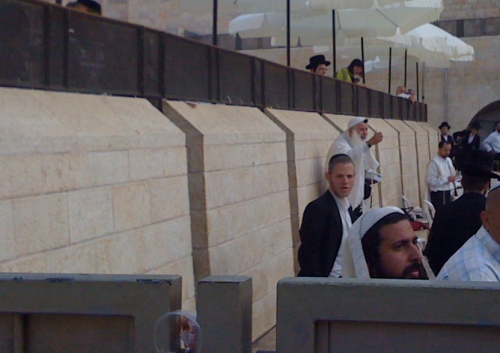By Diana Saverin
JERUSALEM–Starting last night, the Jewish fast of Tisha B’Av began. At 7 P.M., restaurants closed, and a strange quiet hung over the city. Recreational spots across the country have also been shut down for the 25 hours of the fast.
The fast honors the destruction of the two Holy Temples in the Old City, which are said to have been demolished out of a senseless hate. They were destroyed over 600 years apart, but both on the ninth day of the month of Av. Today I watched as hundreds of Jews congregated at the Kotel to commemorate the loss, and read from the Book of Lamentations.
The fast has been expanded over the years to mourn other hardships the Jewish people have faced over thousands of years, which are said to have happened all on this one day. From the Roman conquerors in the city of Betar, to the Crusaders in France, to Jewish expulsion from England and Spain, to the beginning of World War I, to deportations during the Holocaust, to a bombing of a Jewish community center in Buenos Aires, the withdrawal from Gaza which forced Jewish settlers to move in 2005, and more, the fast honors mass suffering of the past.
Today in Jerusalem, the concept of a baseless hate seems pervasive. Hundreds have flocked to the Gilad Shalit protest tent, where I attended a march last week, to lament his captivity, and hope for his return. At the same Wall where hundreds of prayers from the Book of Lamentations will ring today, just last week a woman was arrested for carrying a Torah because of her gender. Just outside of the Old City walls, the residents of Silwan I wrote about a couple of weeks ago await demolitions of their households. Is baseless hatred truly a thing of the past to commemorate, or a continuing characteristic of this crazy city?
For where else in the world do two nations live together on one land, and fight on the battlefields of civilian neighborhoods with construction and demolition? And where else does a religious minority control a democratic government to the point where prayer, religious conversion, and marriage have to follow the rules of the most extreme sector of the religion? And where else do all three of the most prominent religions of the world flock to visit holy sites within yards of each other?
These unique qualities of the city are pulling it apart. A Ynet-Gesher poll of 505 Hebrew-speaking Jewish Israelis revealed 42% of respondents believe the religious-secular divide causes the most tension in Israel and 41% said it was the Jewish-Arab situation. The baseless hatred is palpable amid these divides: 54% believe Arabs are the most hated in Israel, while 37% believe the Haredi Orthodox are the most hated. Jerusalem is a microcosm of this polarization. With the city 35% Arab and 22% Haredi, racial and religious divides are everywhere.
None of this is news. We are all at least vaguely aware of the constant tragedy and complexity of this ongoing conflict, and can recognize the baseless hate on both sides. I often think of the different sides as looking through mirrored windows, only reflecting back the very real pain each has experienced as a result of the continuing tension and the absence of any sustainable or long-term solution, without being able to see past the wall to the suffering on the other side. The tragedy for me lies in this blindness. Both sides have blood on their hands, both sides have pain in their hearts, and both sides bear the responsibility of making it better.
On this holiday, though, I appeal specifically to the Jewish people. Among the many Jewish traditions I have learned to love and admire this summer is the social justice teachings in Judaism. In a lecture last week, a religious man spoke about the role of this Jewish morality in the conflict, and used the metaphor of a grasshopper to describe the respective positions of Israelis and Palestinians. He said that for centuries, the Jews have been the grasshopper, and continue to ask for sympathy for this terrible position they were in for so long. On Tisha B’Av, it’s impossible not to be aware of the gross hardship the Jews have faced, and I sympathize deeply with this position. As the lecturer said, though, Israel is not the grasshopper in this particular conflict anymore; Israel has the upper hand and has become the aggressor. The Palestinians are now the grasshoppers, and Israelis, he says, have a responsibility to realize their privileged position and incorporate Jewish values into their actions moving forward.
This is not to say Jews or Israelis do not continue to face hardship inside and outside of the conflict, or have not in the past. They have, they do, and they will continue to face baseless hatred and adversity. Today, though, I implore Israelis to look past the mirrored window, and see the hatred and adversity Palestinians are facing in this conflict. Israel’s success enables it to change the ongoing tragedies in the region. The Jewish state has been created. Israel has internal and external problems, but it is a recognized and developed nation. Today, Jews can celebrate their promised land, but what can Palestinians celebrate?








